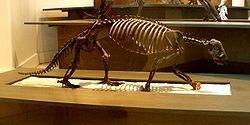Hapalops longiceps
|
Hapalops Temporal range: Early-Late Miocene (Santacrucian-Huayquerian) ~17.5–7.246 Ma |
|
|---|---|
 |
|
| Hapalops ruetimeyeri | |
| Scientific classification | |
| Kingdom: | Animalia |
| Phylum: | Chordata |
| Class: | Mammalia |
| Order: | Xenarthra |
| Family: | †Megatheriidae |
| Subfamily: | †Schismotheriinae |
| Genus: |
Hapalops Ameghino, 1887 |
| Species | |
|
|
Hapalops is an extinct genus of ground sloth from the Early to Late Miocene of Brazil (Solimões Formation), Bolivia (Honda Group), Colombia (Honda Group), and Argentina (Santa Cruz Formation) in South America. Though related to the giant Megatherium, Hapalops was much smaller, measuring about 1 metre (3.3 ft) in length. Like most extinct sloths it is categorized as a ground sloth, but it is believed that the smaller size of Hapalops allowed it to engage in some climbing behaviors.
It had a robust body, short skull and long limbs with large, curved claws. When it did visit the ground the animal probably walked on the knuckles of its forelimbs, like a gorilla. Hapalops had very few teeth with no incisors, the mandible included only four pairs of teeth.
...
Wikipedia
